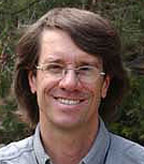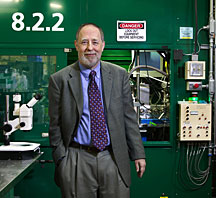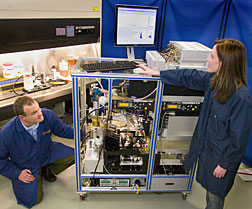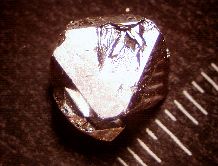| Research
|
Senior Engineer Paul Norton of DOE's National Renewable Energy Laboratory is a variety junkie. He's researched alternative fuels for heavy vehicles, worked on two notable Habitat for Humanity houses and supported DOE's Building America Program. All of this while studying sculpture at the University of Colorado at Boulder. "I'm a mechanical engineer by profession and a kinetic sculptor by avocation," Norton said. Norton began work at NREL as a visiting professional in 1984 and returned as a full-time employee in 1995. He spent several years in the Transportation Technologies and Systems Center before making the transition to the buildings research team. It was at this time Norton began work on a special project that has held his attention for more than five years - working with Habitat for Humanity of Metro Denver on energy efficient, affordable housing. In 2002, Norton worked with Habitat to tweak existing building designs to include additional energy efficient features such as a radiant wall heating system, solar thermal collectors for hot water and increased attic ventilation. "With our first Habitat project, we piggybacked on Habitat's already energy efficient designs," Norton said. "But based on the success of that house, we were able to propose plans for a Zero Energy House." Reaching zero energy in a cold climate was a challenge, so the home was carefully designed to combine the efficiency of the building envelope (insulation, windows, etc.) with efficient heating and cooling equipment, appliances, lighting, passive solar heat and light, solar-electricity, and solar water heating features. So far, the home is exceeding expectations and is has produced more energy that it has used. When not working with Habitat, Norton evaluates the performance of homes in Building America communities and will serve once again on the Instrumentation team for DOE's collegiate building competition, the Solar Decathlon. The creativity each Solar Decathlon team uses in their building design is something Norton appreciates on many levels, as an engineer and as an artist. Norton expresses his creative by making large-scale, steel sculptures. Norton has studied sculpture for a number of years and has had several pieces shown in art galleries in Denver, Colo.Submitted by DOE's National Renewable Energy Laboratory |
|||||||||||||||||||||||||||||
|
Check out the Office of Science's new Website.
|
NETL scientists assist U.S. militaryThe U.S. military have called upon the expertise of the National Energy Technology Laboratory's Office of Research and Development to develop armor that will improve the safety of tanks and other armored vehicles used in the War on Terror. Scientists at NETL, DOE's primary laboratory for materials research, have used their knowledge of materials performance and process development to assist the Army Research Laboratory in Aberdeen, Md., in a number of projects. The materials science research focus area at NETL specializes in formulating, characterizing, and/or melting of most metals, alloys and ceramics; casting and fabrication, prototype development; and the recycle and remediation of waste streams associated with these processes. NETL is one of the few places in the world where alloy development, melting, casting, fabrication, physical and chemical analyses and performance testing (wear, erosion, and various forms of corrosion) can be performed in one place. NETL has successfully transferred the NETL-developed loose bonded sand, lost foam technology for making steel castings to the Rock Island Army Arsenal, Rock Island, Ill. RIAA requested assistance from NETL at the direction of ARL because of NETL's 20-year history in making cast steel and other prototype armor for the U.S. Army. Since RIAA had no facilities for making cast steel armor plate, NETL provided RIAA with process guidelines, parameters, expertise and actual patterns to set up its casting facility. The novel armor holds great promise for protecting heavy convoy vehicles and personnel that are being destroyed or disabled by improvised explosive devices (IEDs) and other roadside bombs. NETL scientists continue to assist RIAA personnel with design and gate patterns for casting armor plate and other process-related information. Under a full cost recovery Military Interagency Payment Request (MIPR), NETL scientists will produce ballistic penetrators for the ARL's Armor Mechanics Branch in Aberdeen, Md. Unable to have the penetrators produced elsewhere, ARL sought the assistance of ORD because of ORD's unique materials capabilities. ORD scientists have determined that the alloy systems for use in sensitive Army ballistic applications can be successfully produced. Penetrators made from this complex alloy system are critical to the performance testing of new armor applications needed to protect soldiers and military systems now being fielded throughout the Army's areas of operations. NETL will also be involved in the development of a process to reduce the weight of the turrets on HUMVEES so that the vehicles will not overturn during combat maneuvering. The goal is to reduce the turret weight from more than 1,200 lbs to less than 600 lbs by replacing the steel-based armor with a combination of titanium alloy and transparent alumnia. This would both lighten the turret and increase the protection for the top gunner, but even more importantly, would offer protection from IEDs. NETL scientists from ORD's Process Development Division have developed a novel process and made a number of prototype titanium plates using a low-cost powder. NETL is collaborating with the titanium powder manufacturer, ARL, the Picatinny Arsenal, and the vehicle manufacturers in this effort.Submitted by DOE's
National Energy |




